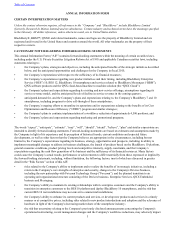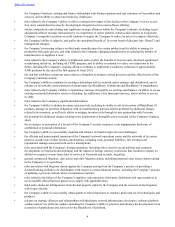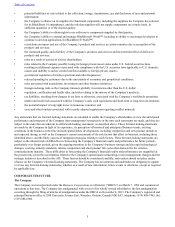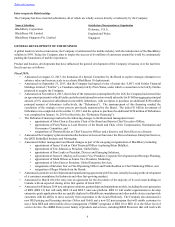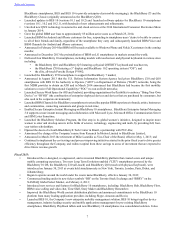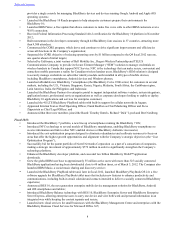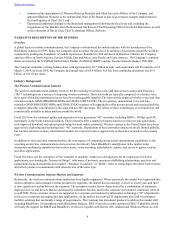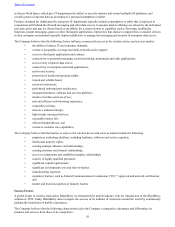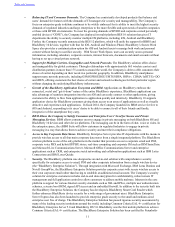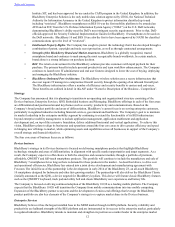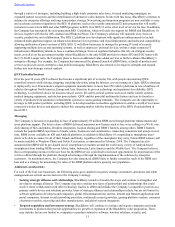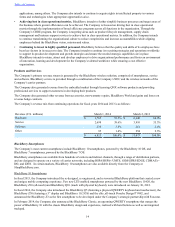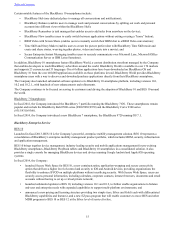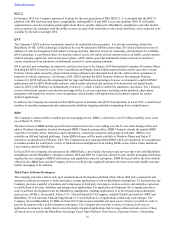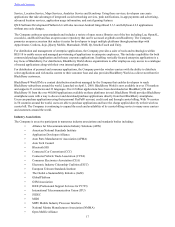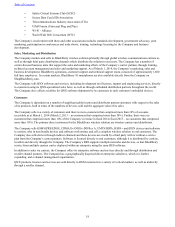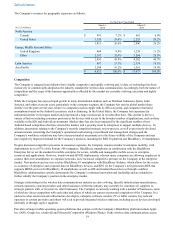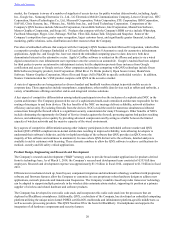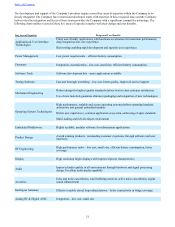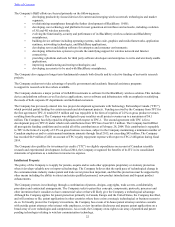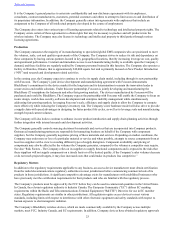Blackberry 2014 Annual Report Download - page 21
Download and view the complete annual report
Please find page 21 of the 2014 Blackberry annual report below. You can navigate through the pages in the report by either clicking on the pages listed below, or by using the keyword search tool below to find specific information within the annual report.
13
through a variety of strategies, including building a high-touch enterprise sales force, focused marketing campaigns, an
expanded partner ecosystem and the identification of alternative sales channels. In line with this focus, BlackBerry continues to
enhance its enterprise offerings and long-term product strategy. New pricing and migration programs are now available to ease
and accelerate customer migration to the BES 10 platform, such as the recently announced EZ pass program that will enable
customers to move from BES and other MDM programs to BES 10 or BES 12 at the silver level of service for free. In addition,
the Company has announced the next-generation BES 12 platform, which will unify the support for BBOS and BlackBerry 10
devices, together with that for iOS, Android and Windows Phone. The Company's solutions will maintain a key focus on
security, productivity and collaboration. The BES 12 platform is in development with significant enhancements to include
enhanced multi-platform support, an enhanced architecture for on-premise and cloud deployments and backwards compatibility
allowing unification of prior versions of BES. BES 12 will allow businesses to manage the growing IT trend of securely
supporting multiple devices and operating systems, as well as employees’ personal devices, within a single corporate IT
infrastructure. BlackBerry intends to have a continued strategic focus on regulated industries that rely on stringent security
needs, as well as on the government market where BlackBerry is the only MDM provider to obtain ATO and FOC status with
the U.S. DoD. Longer term, the Company plans to focus on additional value-added services to further enhance BlackBerry’s
enterprise offerings. For example, the Company has announced the planned launch of eBBM Suite, a family of products and
services to provide secure, enterprise-class mobile messaging. BlackBerry also intends to leverage its strengths and expand
further into new strategic vertical markets.
QNX Embedded business
Over the past 30 years, QNX software has become a significant part of everyday life, with people encountering QNX-
controlled systems while driving, shopping, watching television, using the Internet, or even turning on a light. QNX technology
is deployed by over 40 automotive original equipment manufacturers in more than 250 vehicle platforms in tens of millions of
vehicles throughout North America, Europe and Asia. Based on its proven technology and reputation for reliability, QNX
technology is a preferred choice for mission-critical, secure, life safety-critical systems such as air traffic control systems,
medical imaging equipment, and nuclear power plants. QNX enables powerful multimedia features and can be found in a
variety of products from automotive infotainment systems to casino gaming terminals. The Company sees the opportunity to
leverage its full product portfolio, including QNX, to develop machine-to-machine applications to enable a world of ever-more
connected wireless devices and plans to address this emerging market with the introduction of the QNX Cloud platform in
fiscal 2015.
Messaging
The Company is focused on expanding its base of approximately 85 million BBM users through platform enhancements and
cross-platform support. The latest release of BBM delivered numerous new features such as free voice calling over Wi-Fi, one-
click sharing of files and photos, Dropbox integration, location sharing and BBM Channels, among others. BBM Channels
extends the popular BBM experience to brands, artists, businesses and communities, connecting consumers and groups in real-
time. BBM is now available on iOS and Android platforms, in addition to BlackBerry 10, responding to smartphone users'
desire to be able to connect to all of their friends and family, regardless of the smartphone they carry. Future BBM releases will
be made available to Windows Phone and Nokia X customers, as announced in February 2014. The Company has also
announced that BBM will be pre-loaded on LG smartphones in markets around the world and a variety of Android-based
smartphones from leading OEMs across Africa, India, Indonesia, Latin America and the Middle East. The Company believes
that a corresponding increase in the user base for the BBM service could lead to increased opportunities for monetization of the
services offered through the platform, through advertising or through the implementation of the solutions by enterprise
customers. As mentioned above, the Company has also announced eBBM Suite to further extend the reach of the BBM user
base and as a strategy for monetizing the value of the BBM platform and its growing user population.
Additional considerations
For each of the four core businesses, the following areas-go-to-market/ecosystem, strategic investment, operations and talent
management-are critical success factors to the Company’s strategy:
• Seeking strategic alliances and relationships. BlackBerry intends to broaden the scope and continue to strengthen and
develop its strategic alliances. The Company may also consider new types of partnerships and relationships that could
involve closer collaboration with other technology leaders to affirm and enhance the Company’s competitive position as a
primary mobile device and solutions provider. Areas of strategic alliances and relationships include, but are not limited to,
software application developers and companies, global telecommunications carriers, intranet and Internet applications and
portal companies, Internet social networking providers, multimedia content providers, gaming platform vendors, consumer
electronics retailers, microchip and other manufacturers, and global systems integrators.
• Targeted acquisition and investment strategy. BlackBerry will continue to evaluate and acquire companies and make
investments in products that provide opportunities for growth or expansion of the BlackBerry value proposition. These
may include, but are not limited to, companies or products related to software, wireless solutions, security, and
Table of Contents


